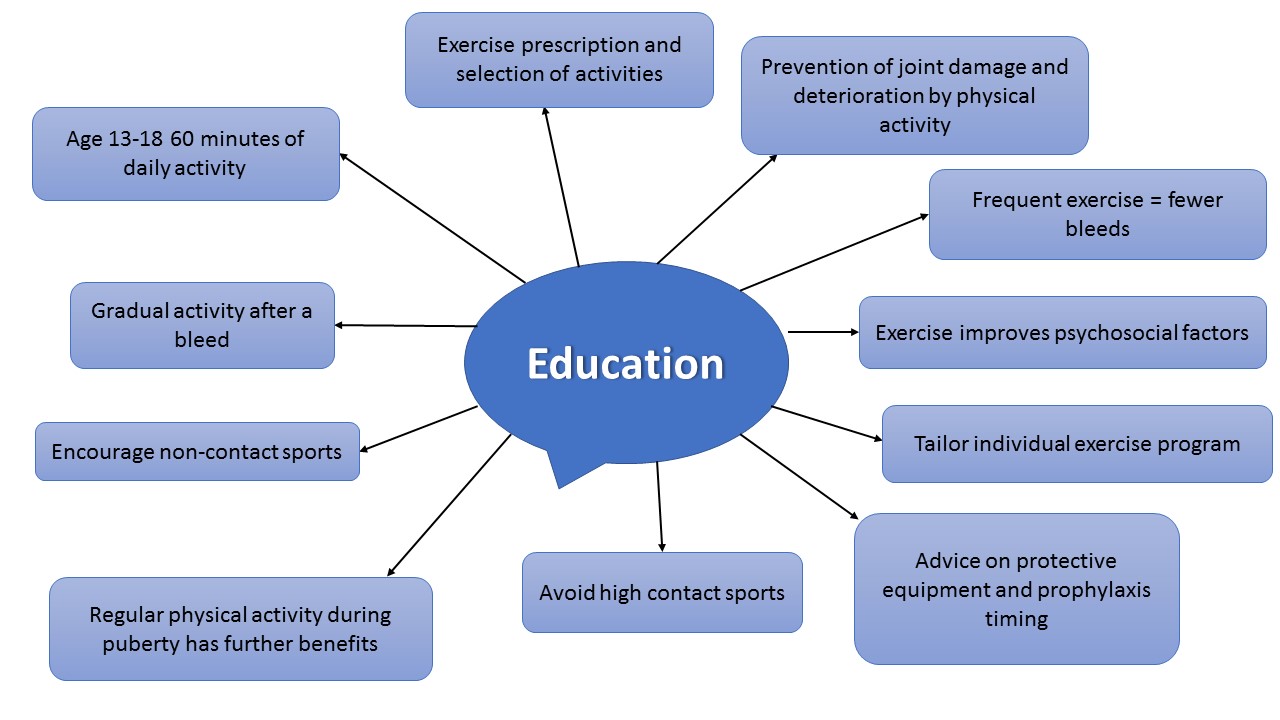Physical Activity in Adolescents with Haemophilia
Original Editor - Your name will be added here if you created the original content for this page.
Top Contributors - Caitlin MacRae, Hazel Burt, Alex Leishman, Chloe Allan, Kim Jackson, Steven flett, Rucha Gadgil, Tarina van der Stockt, 127.0.0.1, Admin, Jane Hislop and Michelle Lee
Introduction[edit | edit source]
Aims and Objectives[edit | edit source]
Background[edit | edit source]
Definitions[edit | edit source]
Incidence and Prevalence[edit | edit source]
Classifications and Severities[edit | edit source]
MDT Involvement[edit | edit source]
Q&A[edit | edit source]
The Role of The Physiotherapist[edit | edit source]
Assessment[edit | edit source]
Management[edit | edit source]
Education[edit | edit source]
Below is a mind map which explains the advice that should be given to patients regarding physical activity. More detail on each is presented in the bullet points below.
The physiotherapist has a crucial role in educating patients regarding physical activity, exercise prescription and selecting particular activities (Heijnen 1993).
It is important to inform patients/relatives/peers that the benefits derived from physical activity can actually help to prevent joint damage and functional impairment (Buzzard 1997).
Individuals who exercise frequently actually exhibit fewer bleeds (Tinktinsky et al 2002).
You should inform patients that just as with healthy individuals, exercise also improves psychosocial factors (Negrier et al. 2008).
The physiotherapist should assist and advise patients on developing an individually tailored physical activity programme (Wittmeier and Mulder 2007).
You must educate the patients regarding protective equipment and timing of prophylaxis administration that is appropriate to their chosen sport or activity (McGee et al 2015; The World Federation of Hemophilia 2015).
The encouragement of the use of protective equipment (e.g. splints, braces) during activity especially if the patients has a target joint, or no clotting factor given prior to activity (Philpott et al. 2010).
Depending on the patients severity of their condition high contact and collision sports such as football, hockey, rugby, boxing, and wrestling are usually best avoided (The World Federation of Haemophilia 2015).
It is important to address the added benefits of physical activity during puberty in adolescents. Regular physical activity participation during puberty, enhances lean tissue mass, fitness and strength and decreases fat mass (Ara et al. 2004).
Physiotherapists should try to encourage non-contact sports such as swimming, walking, cycling, golf, archery, badminton, rowing and sailing (The World Federation of Haemophilia 2015).
It is paramount for physiotherapists to advise patients on the importance of gradually re-introducing activity after a bleed to minimise the chance of a re-ocurring bleed (The World Federation of Haemophilia 2015).
Give advice on appropriate forms of physical activity specific to that patient and their individual preferences, interests and needs (The World Federation of Hemophilia 2015).
Advice on amount of physical activity is no different to national guidelines for healthy individuals. Young people between the ages of 13-18 should participate in a minimum of 60 minutes of daily activity (Department of Health 2011).
It is advised that school personnel should be educated regarding suitable activities for the child, immediate care in case of a bleed, and modifications in activities that may be needed after bleeds (The World Federation of Hemophilia 2015).�
Physical Activity Promotion[edit | edit source]
Managing Risks and Considerations[edit | edit source]
PPE[edit | edit source]
How to Approach Conversations Regarding PA[edit | edit source]
Benefits of Physical Activity[edit | edit source]
Obesity[edit | edit source]
Childhood Development[edit | edit source]
Quality of Life[edit | edit source]
Policies and Guidelines[edit | edit source]
Recent Related Research (from Pubmed)[edit | edit source]
Extension:RSS -- Error: Not a valid URL: Feed goes here!!|charset=UTF-8|short|max=10
References[edit | edit source]
References will automatically be added here, see adding references tutorial.







